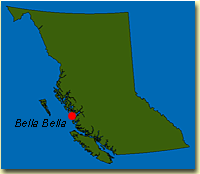| Home |
| Who We Are |
| Gallery |
| Fisheries |
| LRMP |
| Papers |
| News |
| Contact Us |
 The Heiltsuk people have lived in their lands, on what has become the Central Coast of British Columbia, since time immemorial. Formerly known as the Bella Bella Indians, the Heiltsuk speak Hailhzaqvla, the Heiltsuk language. It is considered a separate language but is part of what linguists call the Wakashan Language Family.
The Heiltsuk people have lived in their lands, on what has become the Central Coast of British Columbia, since time immemorial. Formerly known as the Bella Bella Indians, the Heiltsuk speak Hailhzaqvla, the Heiltsuk language. It is considered a separate language but is part of what linguists call the Wakashan Language Family.
Heiltsuk oral tradition states that the original Heiltsuk ancestors were set down by the Creator in various areas in the territory now referred to as the Central Coast of British Columbia, before the time of the great flood.
 The Heiltsuk people lived in many villages and seasonal camp locations throughout Heiltsuk territory. There were a number of tribal groups that lived in areas of Heiltsuk territory for millennia. After contact, as a result of disease and increased conflict on the coast, villages and whole tribal groups tended to concentrate in some locations, eventually coming together at McLoughlin Bay between the 1860s and 1890s. This village was called 'Qlc or Bella Bella. The village moved in the 1890's to the present site of Bella Bella, which is also known as Waglisla.
The Heiltsuk people lived in many villages and seasonal camp locations throughout Heiltsuk territory. There were a number of tribal groups that lived in areas of Heiltsuk territory for millennia. After contact, as a result of disease and increased conflict on the coast, villages and whole tribal groups tended to concentrate in some locations, eventually coming together at McLoughlin Bay between the 1860s and 1890s. This village was called 'Qlc or Bella Bella. The village moved in the 1890's to the present site of Bella Bella, which is also known as Waglisla.
From a large pre-contact population the Heiltsuk dropped to just over 200 in the early part of this century. It is estimated that nearly 85% of the population died during the nineteenth century. The population decline reversed itself following the 1918 'flu epidemic.
Like our neighbours on the coast, the Heiltsuk were subject to pressure from colonization and attempts to assimilate us into the Euro-Canadian society.
Pressure from missionaries, government, and hospital staff was applied to the Heiltsuk to abandon their traditional beliefs and practices. Many practices were forced underground by this pressure. The Potlatch, an institution involving public feasting and display and public witnessing of business, was outlawed by the Federal government from the late nineteenth century until 1951. Heiltsuk children were required to attend the now infamous Residential schools, where they were given poor quality education, low quality food, and subjected to curriculum designed to assimilate them. Native languages were forbidden at these schools, even though it was the only language many children spoke. Many children were subjected to psychological, physical and sexual abuse while attending these schools. The Residential School System was part of a government policy of assimilation of First Nations.
Despite these forces acting upon the Heiltsuk, there remains today a Heiltsuk Nation that is striving to retain its lands, and culture. During this century the Heiltsuk have maintained close ties to their land and resources. The language and potlatch system survived. Traditional foods continue to be harvested and preserved from the land. These foods contribute significantly to the contemporary diet and local economy.
The Heiltsuk are now working to preserve their language. Today it is taught in the school. There is a challenge to maintaining the language. Funding for curriculum development is scarce.
The Heiltsuk have never surrendered their aboriginal rights or title. Leaders of the community have struggled to address the land question through out this century. As one chief said in 1913:
|
"We are the natives of this Country and we want all the land we can get. We feel that we own the whole of this Country, every bit of it, and ought to have something to say about it. The Government have not bought any land from us so far as we know and we are simply lending this land to the Government. We own it all. We will never change our minds in that respect, and after we are dead our children will still hold on to the same ideas. It does not matter how long the Government take to determine this question, we will remain the same in our ideas about this matter. The British Columbia Government are selling the land all around us, and we do not know but they might well it all, even including these Reserves, in time. We consider that the Government is stealing that land from us, and we also understand that it is unlawful for the Government to take this land." Bob Anderson |
The Heiltsuk became involved in the Comprehensive Claims Process in 1981. When the current Treaty Process began, the Heiltsuk immediately filed their statement of intent and have been actively involved in trying to resolve the land question with the federal and provincial Canadian governments.